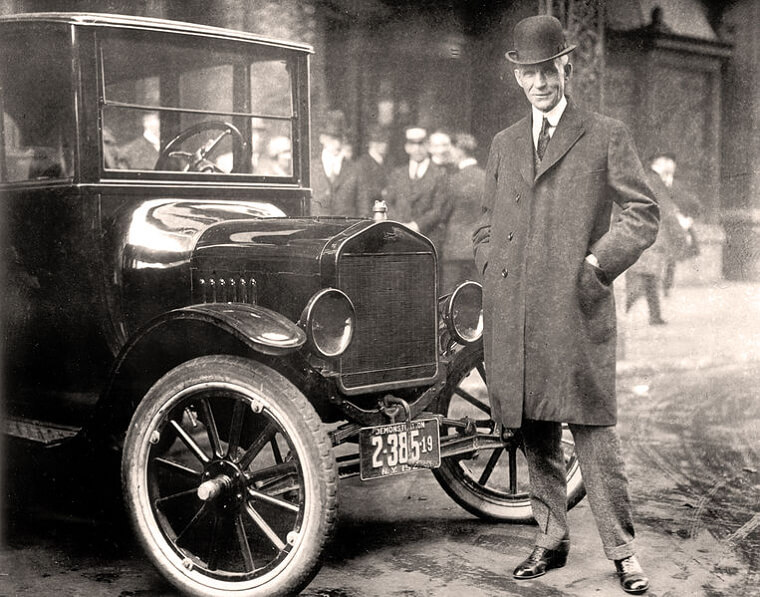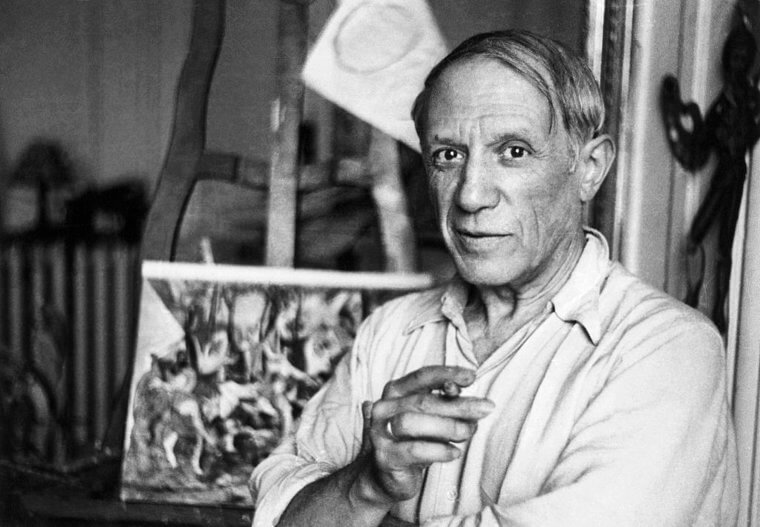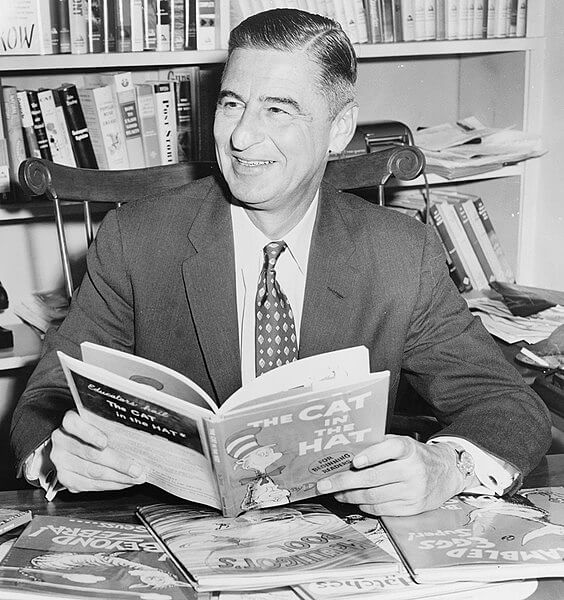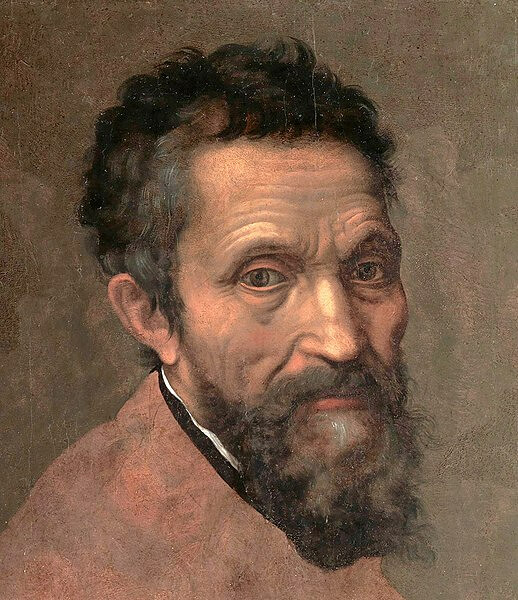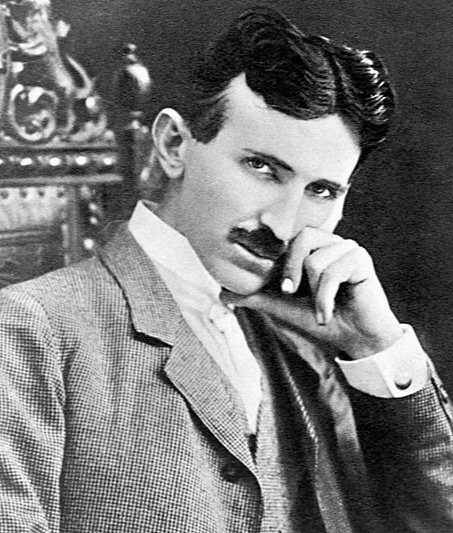Charlie Chaplin Met His Future Wife When She Was 12 and He Was 31
In case it wasn't already clear, Charlie Chaplin was quite a bit older than his wife when the two first met. He was in his mid-30s when he met his wife-to-be, who was 12 at the time. Things were quite a bit different back in the day. This fact alone is kind of gross, but add to it that he abandoned her after the two were married, and things just get worse.
Despite things being a little different back in the day, this particular incident was still considered a scandal and was talked about and gossiped over pretty extensively when it occurred.
Historians Say Winston Churchill Was Responsible for the Bengal Famine That Killed Millions
Most historical depictions of former British prime minister Winston Churchill involve him leading the country through the depths of World War II. However, like so many others on this list, historians say that the former prime minister also had a darker side. In 1943, India was in the midst of a devastating famine, and British policies at the time were accused of causing or making the famine worse.
It was so bad that around 3 million people died as a result of the famine. Today, many Indians and others lay the blame squarely on Churchill's shoulders.
Steve Jobs Denied His Daughter Was His and Fought Paying Child Support
Steve Jobs is mostly remembered for his role at Apple and his work in turning the company into a technology giant. But many can also probably point to a controversy or two surrounding the late Jobs, such as the way he treated his employees and colleagues. There's also the incident in which he tried to deny he was the father of his daughter, going as far as to fight her mother in court over child support.
He ended up denying the claim for around seven years, but he did eventually accept that he had a daughter, and the two were reportedly on good terms afterward.
PT Barnum Held a Public Autopsy on a Human Slave
PT Barnum is a well-known historical figure, even if he's not exactly taught in classrooms. He's mostly known for his work in promoting circuses. However, what's less known is just how extreme the lengths were that he went to in order to attract people to his circuses. They were so extreme that he once held a public autopsy on one of his human slaves. The autopsy was held in the New York City Saloon.
By all accounts, it was a pretty gruesome spectacle and one that people should know about when it comes to the famous showman, who apparently exploited people for his own gain.
Henry Ford Was a Nazi Sympathizer
Henry Ford is usually remembered as a great American innovator who brought cheap, affordable cars to the masses. That might be true, but it's also true that Ford was a Nazi Sympathizer and known anti-semite. According to a friend of his, he once said "The Jews caused the war, the Jews caused the outbreak of thieving and robbery all over the country, the Jews caused the inefficiency of the navy," according to PBS.
Perhaps not surprisingly, he was known to entertain conspiracy theories and even bought a paper in Michigan to spread conspiracy theories. Adolf Hitler even looked to Ford as evidence that anti-semitism could thrive in the U.S.
The Wright Brothers Intentionally Hindered Other People's Aviation Progress
Today, the Wright brothers are largely credited with being the first to build and fly a working plane. There are some who say others were first, but we're going by what the Smithsonian says on this one. One thing that is for sure is that the Wright brothers likely hindered aviation advances, at least in the U.S., after their first flight. That's because they tried to file a federal patent for flying.
This created some legal roadblocks for people who were looking to innovate and create better planes in America, a fact that culminated in Americans having to fly European planes when they entered World War I.
Helen Keller Supported Eugenics and Euthanasia
Helen Keller is known pretty well for her struggle to overcome her disabilities, but her social life and advocacy are talked about far less. The Alabama native spoke out against racism and inequality. She was so active that she was pretty much considered a superstar of her era, often rubbing shoulders with other famous individuals, such as Charlie Chaplin and Mark Twain. But she held controversial opinions, too, such as support for euthanasia in at least one case.
Not only that, but she spoke in pretty harsh terms about who should be afforded life and who shouldn't. However, she apparently shifted her stance later in her life.
Pablo Picasso Abused and Mistreated Women
It's pretty well documented by now that Pablo Picasso, while a great artist, wasn't the best human being. He reportedly abused his girlfriends and severely mistreated his wife. He allegedly once told one of his mistresses, "Women are machines for suffering" and "For me, there are only two kinds of women: goddesses and doormats." If that doesn't scream misogynistic, then we aren't quite sure what would. However, there are some differing opinions on whether or not he was physically abusive.
People are still wrestling with Picasso's legacy to this day, with articles talking about his abuse and work appearing regularly in magazines and websites that discuss art.
Mother Teresa Encouraged Ill Patients to Suffer but Went Straight to the Hospital if She Was Sick
Mother Teresa is another historical figure who deeply divides opinions. Many regard her as a living saint who devoted her life to taking care of people others wouldn't take care of. However, many also accuse her of allowing her patients to suffer because she believed that this was one way of being closer to God. She was also criticized by some in India and accused of only working with the poor in order to convert them to Christianity.
Critics of her methods point to the fact that she received proper medical care when she was sick and ailing, proving that she could have provided the same for her patients.
Rosa Parks' Refusal to Go to the Back of the Bus Was 100% Planned
When you learn about the history-making Rosa Parks in class, the story often makes it sound like it was a spur-of-the-moment thing and that she one day just decided enough was enough. However, that's not exactly the case. In fact, the act was planned in advance as a form of civil disobedience. Not only that, but a Black woman named Claudette Colvin had done the same thing on a Montgomery bus around nine months prior.
But because Colvin was pregnant out of wedlock and poor, her story wasn't showcased as much. Still, both women deserve a lot of respect for their work during the Civil Rights Movement.
Dr. Seuss Had an Affair With a Family Friend That Had Devastating Effects on His Wife
It's nearly impossible to grow up without having read at least one book by Dr. Seuss as a child. However, it turns out the children's author had a couple of skeletons in his closet. Apparently, he had an affair with a family friend while his wife was suffering from Guillain-Barré syndrome. The disease caused partial paralysis and depression in his wife. This, coupled with the affair, eventually led her to commit suicide.
The author's work has also been under fire in recent years because of his use of racist stereotypes, which are far more apparent in the adult work the author did in his earlier years.
Sigmund Freud Was a Cocaine Addict
You don't have to know a lot about psychiatry to have heard of the name Sigmund Freud. He is responsible for creating the field of psychoanalysis and for developing many of modern psychiatry's foundational principles. However, he was also a notorious drug addict and reportedly loved cocaine. He even suggested that a friend use it to ween themselves off of morphine. It's thought that this led to their premature death.
It's thought that he loved the drug so much it actually influenced some of his work. In addition, he had some pretty controversial views on women that would probably be viewed as sexist in today's society.
Mahatma Gandhi Made Underage Girls Sleep With Him
Traditionally, Mahatma Gandhi was one of those historical figures that people used to look at and think that they could do no wrong. We now know that isn't exactly the truth. It turns out that despite all of his work for peace and India's independence, Gandhi took part in some pretty sketchy practices. He reportedly forced underage girls to sleep with him in the same bed. Not only this, but everyone was also apparently naked.
Some say he used this as a sort of celibacy test, while others accuse him of rape. Either way, most people certainly wouldn't view the practice as okay had they known about it.
Charles Lindbergh Had Multiple Children With German Mistresses
Charles Lindbergh is one of the most famous American aviators in history. He led a seemingly exciting life in the early 20th century, but not too many people are aware of some of the more controversial aspects of his life. For example, he became an ardent Nazi sympathizer in later life and worked to keep America out of the war in Europe, the former of which saw him stripped of his statue as a national hero, according to PBS.
In addition, he fathered multiple children by mistresses in Germany. Some of these children only came out with their stories as late as the 2000s, shedding light on another dark side of Lindbergh's life.
Eleanor Roosevelt Had Affairs With Women
Eleanor Roosevelt's legacy as a First Lady is a large one in American history. She is credited with urging the U.S. to join the United Nations after World War II, among many other notable achievements. She may have also been America's first lesbian First Lady. She had many openly lesbian friends and also shared this in a letter with one of them: "The feeling of that soft spot just northeast of the corner of your mouth against my lips."
Because of this, many historians and even people at the time suspect that she may have had an affair while she was married, although it's not known for certain.
Albert Einstein Never Visited His Schizophrenic Son After Emigrating to the USA
You'd probably have to be from another planet to never have heard of Albert Einstein. He's often given the unofficial title of one of history's smartest individuals. However, the scientist could be quite cold when it came to social matters, which is apparent in the way he treated his son. The son was committed to a ward because of his schizophrenia, but Einstein failed to visit him over the course of his life.
His son lived all of his life in the ward and ended up dying there at the age of 55. That said, the two did exchange letters rather frequently.
Coco Chanel Was a Nazi Spy
There seem to be a lot of heads of companies that can say they associated with or were sympathetic to the Nazis during World War II. Here's another in the form of Coco Chanel. The fashion icon reportedly worked with and had relations with high-ranking nazi officials while in Vichy, France, during the war. It's also probably one of the reasons the company managed to gain such prominence and is around today.
She was reportedly so involved with the nazis that she was, at one point or another, a nazi informant or spy. However, she was far from the only person who used the war for their own gain.
John Lennon Was Physically Abusive to His Family Members
There are plenty of artists and musicians on this list, but the last person you'd expect to be physically abusive might be John Lennon. The man was responsible for numerous songs calling for world peace and other lofty goals. However, it turns out that Lennon failed to live up to his own ideals and was physically abusive toward his wife and kids. He even openly admitted to hitting his wife.
However, this was reportedly earlier in his life, and he is said to have changed his ways after his first marriage. That said, his son spoke pretty bluntly about his father's darker side.
Andy Warhol "Paid" Artists in Exposure, Not Money
Andy Warhol is considered an icon when it comes to 20th-century art. However, like others on this list, he wasn't without controversy. Warhol was accused of "paying" artists in exposure at his factory. In other words, he pretty much made them work for free while he was making a profit. People also accuse him of introducing drugs to a muse of his. She eventually overdosed and died of these drugs. There have also been some copyright issues associated with Warhol that have popped up in recent years.
So, in short, Warhol is like many other artists, and he has his fair share of controversy surrounding both his personal life and his artwork, which inspired a genre.
Alfred Hitchcock Mistreated His Actors
Alfred Hitchcock is known as one of the greatest directors there ever and a gargantuan figure when it comes to the history of film. Some of his movies are still rated as among some of the best-to-ever grace screens. That said, he was also accused of mistreating his actors and putting his pursuit of perfection over their well-being. For example, he once released real birds on set and allowed them to attack actors while he filmed.
That's why actor Tippi Hedren's performance in The Birds looks so genuine because it is. She was terrified that the birds would poke her eyes out and harm her.
Pocahontas Was Only 11 When She First Met John Smith
Despite her fame, surprisingly little is known for sure about Pocahontas. Despite the popular Disney movie, there are a lot of conflicting claims about how actual events unfolded when Pocahontas met John Smith in what is now New England. What historians are fairly sure of is that Pocahontas was young when the two first met, probably around 11 years old. She also had a lot of contact with the arriving colonists.
However, beyond that, there is little that is known for sure. Still, for whatever reason, her story has remained popular enough to be turned into poems, stories, and movies centuries after her death.
Elvis Met (and Dated) His Future Wife When She Was 14
We're not entirely sure what the deal is with famous historic icons meeting and eventually having relationships with underage women, but it seems like it tended to happen entirely too much. Here's a name that you may or may not have expected to hear associated with an underage woman. Elvis apparently met his wife-to-be when she was only 14, although the two waited till she was 21 to officially marry.
There are also a couple of different accounts as to what actually took place when she was underage, but still. In a later biography, she said that the two's relationship wasn't sexual until after they had married.
Lyndon B. Johnson Was Not Very Presidential When Discussing His Body Parts
Lyndon B Johnson took over the presidency at a pretty consequential time in American history. John F. Kennedy had just been assassinated, and the war in Vietnam was raging. So, he's often covered in a bit more depth in American history classes, but this next part isn't talked about as much. Johnson was known for being pretty lewd and even referred to a specific body part of his as "jumbo."
You can probably guess which part we're talking about, so we won't go into it further, but he was also known for waving that same body part around at parties.
Benjamin Franklin Really Liked the Ladies
Despite what some believe, Benjamin Franklin didn't actually invent electricity. That would come a lot later in history, and he was simply trying to prove that electricity and lightning were connected when he executed his famous kite experiment. However, it says a lot about Franklin's enduring myth. He's the only non-president to be featured on a U.S. currency and one of the most famous founding fathers. He wore a lot of different hats during his life.
He served as the first U.S. ambassador to France, helping ensure French aid during the American Revolution. This is also where his legendary love for women gained steam. Today, there are numerous papers and books devoted to Franklin's "adventures."
Before He Became Famous, Michelangelo Took Part in Art Fraud
If you ever need a story that proves it's never too late to achieve something great, look no further than the story of Michelangelo. The famous artist is responsible for, among other things, the Sistine Chapel. However, before his name went down in history among the likes of Aristotle and Leonardo Da Vinci, Michelangelo participated in art fraud. That's right, the famous artist produced a fake, but it wasn't all his fault.
His patron, Lorenzo di Pierfrancesco, asked him to try and make one of his statues look older than it actually was in order to pass it off as an antique and get more money for it. However, the two were caught after it was sold.
Thomas Edison Would Take Credit For Other's Work
Inventor Thomas Edison created or improved on a lot of pretty useful things that we rely on pretty heavily in modern society. For example, he took credit for something called a Kinetograph, which was an early film camera, when a colleague of his actually invented it. He later fired the colleague, according to the Library of Congress. There are differing opinions on how many things he took credit for but didn't invent, but it's probably safe to say it was more than just the Kinetograph.
That said, Edison was a master when it came to marketing and business, which is part of the reason so many different inventions are attributed to him today.
Mark Twain Was a Lieutenant in a Confederate Militia During the Civil War
Born in the Antebellum South, author Mark Twain is probably best known for his anti-slavery stances and writings. However, it turns out that the author, at one point, had actually joined a Confederate militia during the Civil War. He did eventually desert, and many think this was because he wasn't necessarily too thrilled about the cause of the Confederacy. Because of all of his writings, we also know that his beliefs grew more anti-imperialist and anti-slavery as he grew older.
Still, it's kind of surprising knowing that the author of "The Adventures of Huckleberry Finn" once joined up with a Confederate militia, even if for a time.
John Wayne Said and Did Some Pretty Racist Things
John Wayne is often held up as the epitome of American masculinity for his work portraying cowboys in old Western flicks. He may have been a good actor, but his personal beliefs certainly weren't as admirable. He was a notorious racist, antisemite, and homophobe. He also allegedly tried to assault Sacheen Littlefeather during the Oscars one year, although this claim was later debunked by historians, according to The Washington Post and The Los Angeles Times.
That said, the fact that the story stuck around and is still thought to be true by many speaks to how controversial Wayne was. For example, he once told Playboy Magazine, "I believe in white supremacy until the blacks are educated to the point of responsibility. I don't believe in giving authority and positions of leadership and judgment to irresponsible people."
George Washington Carver Didn't Invent Peanut Butter
American inventor George Washington Carver is known and taught in classes for his many inventions involving peanuts. Carter came up with around 300 different uses for peanuts. So, it's not hard to see why some mistake him for the inventor of peanut butter. In reality, people have long been making peanut butter, possibly for thousands of years. Still, Carter was a prolific inventor and used not only peanuts but also sweet potatoes to concoct recipes and materials.
Some of those include things like instant coffee, shaving cream, shoe stain, wood stain, and numerous other products. However, peanut butter was not one of those inventions.
Charles Darwin Consumed All Kinds of Exotic Animals
Everyone learns about Charles Darwin when they're in school. He's the father of the theory of evolution, and despite his views seeming pretty radical at the time they were released, they now form the basis for how we understand life on Earth. So, you might expect that he'd be a big-time conservationist. Well, it turns out that he was complicated. You see, he had a penchant for seeking out and eating exotic animals.
He even formed something called the "Glutton Club" to try "birds and beasts, which were before unknown to the human palate," to see how they tasted and if they were good to eat.
Sherlock Holmes Author Arthur Conan Doyle Believed in Fairies
You probably wouldn't think that the mind behind Sherlock Holmes would believe in fairies. After all, Holmes was known for using logic and science to pin down perpetrators. He never once dabbled in the superstitious. However, the author behind the famous detective was different, and he reportedly believed in the existence of fairies. Not only that, but he spoke passionately about his beliefs and even offered a doctored photo as proof of their existence once.
Apparently, as if some kind of supernatural floodgate had opened, Doyle became really into spiritualism later in his life after a family member passed, which is when his fairy beliefs became public knowledge.
Sacagawea Was Probably Bought By Her Husband When She Was Just 13 Years Old
Sacagawea is probably one of the most famous historical icons from early American history. She was integral to the expedition taken by Lewis and Clark to explore the Western portion of the U.S. However, not many people know that historians believe she had either been won from gambling or bought by her husband, Canadian trapper Toussaint Charbonneau. Apparently, she had been stolen by a neighboring tribe during a conflict, which is how she came to be sold to Charbonneau.
Charbonneau wasn't particularly liked by those on the expedition either, with Meriwether Lewis once calling him "a man of no particular merit" and William Clark intervening after he struck his wife on one occasion. Clark even ended up adopting Charbonneau's children after the expedition.
Nikola Tesla Thought He Could Communicate With NYC's Pigeons
Inventor Nikola Tesla is remembered and probably partly loved for being eccentric. However, not many people really know just how eccentric the Serbian-born American actually was. After his brother died when he was a child, he claimed to have had visions of some kind. When he was living in New York later in life, he would feed the pigeons, and he even told people that he could communicate with them.
According to the Encyclopedia Britannica, he even once talked about a pigeon as if it were a woman, saying that "I loved that pigeon as a man loves a woman, and she loved me."
St. Patrick Didn't Actually Banish Snakes From Ireland
This one may or may not come as a surprise to some. It turns out that old legend about banning all the snakes from Ireland isn't actually why the island doesn't have any snakes. It probably has more to do with the climate. Instead, St. Patrick converted thousands of Irish to Christianity, which is why many Irish are devoutly Catholic. Still, the snake legend does have a bit of charm to it.
We're not even really sure how that would go down, but the image of thousands of snakes just slithering away from Ireland is both curious and dreadful at the same time.
Leonardo Da Vinci Dissected Humans and Animals for Art
Leonardo Da Vinci is remembered as perhaps one of the greatest artists and inventors to have ever lived. He created sketches of cities and humans that were so precise they seemed impossible before he came along. It turns out that for the latter, he employed a pretty scientific if a little gruesome, technique. He actually dissected humans to study different body parts and try to learn how they functioned.
It's estimated that he dissected around 30 different bodies, and his work was surprisingly done in the open, so there weren't any restrictions placed on him by the government or church.
Napoleon Wasn't Really That Short - He Was Actually Average
Depending on where you're from, Napoleon is either a hero or a tyrant. He conquered nearly all of Europe and was considered a military genius. Popular legend also has it that he was pretty short, and people have even coined the term Napoleon complex. However, it turns out that he was actually probably average height when he lived. Whether or not he was upset at not being taller is another matter.
Still, it's hard to imagine him standing eye to eye with most others after having it ingrained into us that Napoleon was rather short compared to his countrymen.
Cleopatra Was a Legit Genius
When we hear about Cleopatra, it's often in the context of Rome, Marc Antony, or Julius Ceasar. That part of her story does have all of the intrigue of modern soap operas, probably even more, but she was also pretty interesting in her own right. For one, she spoke around nine different languages and was considered brilliant when it came to math and philosophy. Oh, and she was the ruler of an entire empire.
During her rule, Egypt grew in size and prosperity, at least up until Rome conquered it. Still, Cleopatra was able to accomplish quite a bit in her short time as ruler.
Joan of Arc's Major Offense: Wearing Men's Clothing
Joan of Arc is a history-making icon, and her achievements were pretty remarkable if you go back and look at them in detail. She led the French to some astounding victories over the English when it seemed like the country might be overtaken during the 100 Years' War. However, she was eventually caught and burned at the stake by the English on charges of heresy, witchcraft, and... wearing men's clothing.
Yes, it was considered a major offense for a woman to wear men's clothing during that time period, at least if you found yourself leading armies against the English.
Alexander the Great May Have Been Buried Alive
Despite the larger-than-life legend of Alexander the Great, historians still aren't quite sure where he was buried when he died. Alexander took around 10,000 men from Macedonia and managed to conquer what was then a superpower in the Persian Empire and make gains as far as India. Popular legend has usually gone that he died at a young age from illness, poison, or due to injury. However, that might not be the case.
It turns out that the famed conqueror may have suffered from Guillain-Barré, which can cause bouts of paralysis. This, combined with accounts his body didn't decompose for nearly a week, has led historians to speculate if he was buried alive during one of these bouts.
Susan B. Anthony Was Heavily Involved in Anti-Slavery Activism Since 16 Years Old
Susan B. Anthony is mostly known for her historical work on women's rights. However, she was actually involved in a couple of different movements, including anti-slaver activism. She even helped slaves escape, held a rally against slavery, and worked to gather signatures advocating for the 13th Amendment. In total, her career in activism spanned around seven decades, first fighting for abolition and then for women's suffrage, according to the Smithsonian.
Her family also apparently traveled around quite a bit supporting abolitionism, so that probably had some effect on a young Anthony and had something to do with her continued activism when she became an adult.




